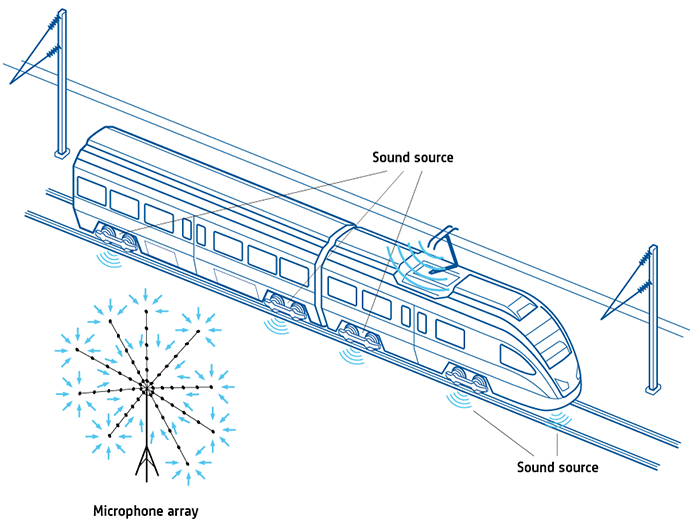
Noise Source Identification (NSI)
Noise Source Identification (NSI) is an essential tool to reduce noise, and to understand and optimize noise that cannot be eliminated. With Brüel & Kjær noise source identification equipment, acousticians can diagnose, visualize, understand and solve noise issues. By tracing noise back to very specific components, engineers can target their mitigation efforts more accurately.
Identification, mitigation and optimization
After locating noise sources, acoustical hotspots and leaks using a variety of tools ranging from hydrophones to outdoor arrays of up to 144 channels, it is possible to identify and characterize the most important sub-sources.
Ranking these helps decide where mitigation strategies can most effectively reduce overall sound power radiation, or reduce certain noise components such as specific frequency content. Mitigating noise can be accomplished by reducing, damping, or decoupling noise sources from the overall structure.
Through the iterative use of NSI tools in the design and prototype phases of product development, the overall noise profile of the product can be optimized, thus ensuring proper compliance with given noise limits and regulations.
Colour-coded noise maps
Different stages of noise-source identification call for different capabilities. Early 'snapshot' measurements such as in aircraft cabins, demand equipment that is easy to deploy in order to obtain results as quickly as possible.
Our software displays sound values as colour-contours in high-resolution noise maps that are easy to interpret.
For fine, close-up detail such as on a hearing aid, acoustic holography delivers similar results in high resolution, while for noise source location on larger objects such as vehicles in a wind tunnel, or from a distance, beamforming can quickly identify noise contributions.
When dealing with moving objects, such as wind turbines and flying aircraft, this can be acoustically mapped using moving-source beamforming.
-
Acoustic Holography
For measurements close to a source, acoustic holography provides fast and accurate acoustic maps of sound pressure, sound intensity and other sound field parameters at low to medium frequencies (100 Hz to 2 kHz).
-
Underwater Acoustic Ranging
Acoustic detection and identification techniques continuously become more advanced and sophisticated. As they evolve, so must acoustic stealth strategies.
-
Wind Tunnel Acoustic Testing – Aerospace
Reduction of noise emissions is a critical technology for aircraft manufacturers and various analytical, empirical and numerical tools exist to help in the design of quieter aircraft.
-
Wind Tunnel Testing For Cars
For many vehicle manufacturers, wind-tunnel measurements are the only way to recreate real-world conditions for testing model and mule cars.
-
Beamforming
An easy, one-shot measurement process for mapping the relative sound pressure and sound intensity contribution from a source.
-
Flight Certification
As global air travel grows, so does the concern for noise around airports. This leads to increasingly strict legislation of exterior noise.
-
Flyover Noise Source Identification
To map noise sources on flying aircraft, Brüel & Kjær’s flyover beamforming software traces sound to individual engine or airframe sources.
-
Real-Time Noise Source Identification With Acoustic Camera
Designed primarily for use in the aerospace and automotive industries, BK Connect Acoustic Camera is a versatile and complete hand-held system for real-time noise source identification in almost any acoustic environment.
-
Ramp Noise Testing
Ramp noise is a standardized acoustic on-ground measurement, detailing the noise print on a parked aircraft.
-
Sound Intensity Mapping
Sound intensity mapping is one of a number of noise identification techniques available to engineers working on noise, vibration and harshness problems.
-
Spherical Beamforming
Ideal for in-cabin noise and leak detection, spherical beamforming is a quick way of mapping relative sound pressure and sound intensity arriving from all directions.
-
Static Engine Noise Certification
Static aircraft engine noise ground tests are performed to define the engine ground static noise measurements.

Iscriviti alla nostra Newsletter e ricevi le informazioni più recenti dal mondo del suoni e delle vibrazioni

